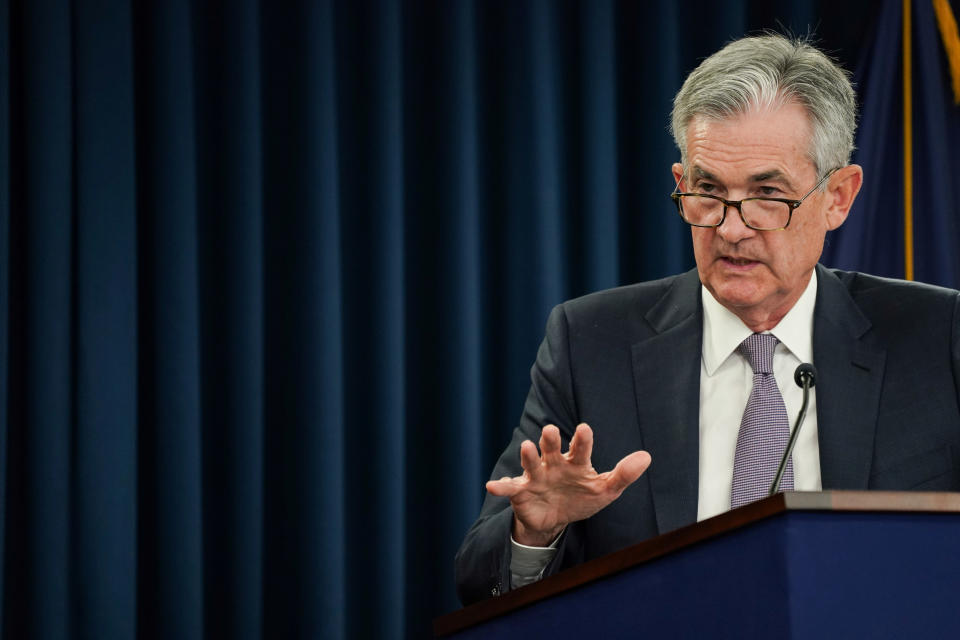Fed meeting minutes – What to know in markets Wednesday
The Federal Reserve’s minutes from its mid-September meeting will pull back the curtain on the deliberations that led to monetary policymaker’s second consecutive rate cut this year, and will help hint at whether further policy easing is yet to come.
The meeting minutes are set for release at 2 p.m. ET, and come halfway between the Fed’s Sept. 17-18 meeting and its next rate-setting session October 29-30.
In September, a divided Fed voted in favor of bringing the benchmark interest rate down a quarter point to a band of between 1.75% and 2.00%. Three officials had voted against the decision, with Kansas City Fed President Esther George and Boston Fed President Eric Rosengren calling for rates to remain unchanged from their previous level, and St. Louis Fed President James Bullard calling for a more aggressive half-point reduction.
“Going by the accompanying ‘dot plot,’ close to a third of officials disagreed with the decision to cut rates at the September meeting, and a third projected leaving rates unchanged from then on. That leaves only a third in favor of more action this year,” Paul Ashworth, chief U.S. economist for Capital Economics, wrote in a note Friday. “The minutes should give us better insight into what it would take to convince that two-thirds majority to change their mind and vote for another cut later this year.”
In the weeks since the Fed’s last meeting, data on the domestic economy has weakened considerably, offering a stronger case for lower rates to help prop up flagging growth. As of Tuesday afternoon, markets priced in an about 80% probability of another quarter point cut to the benchmark interest rate after the October meeting, up from around a 30% probability just a few weeks ago.
Activity in the U.S. manufacturing sector, which has been enduring a well-documented slowdown this year, fell to a 10-year low in September, the Institute of Supply Management said last week. The larger U.S. service sector also saw activity decelerate for the month to a three-year low, stoking fears that a growth slowdown had spilled over into sectors that had previously remained more robust. And the September jobs report came in mixed, with unemployment rate hitting a new 50-year low but job gains coming in at a slightly slower-than-expected pace, with softness especially appearing in retail and goods-producing employment.
“In our view, recent deterioration in ISM business sentiment domestically and abroad, and the continuing trade policy uncertainty are likely to push the core of the committee to cut rates at the October meeting,” James Sweeney of Credit Suisse wrote in a note last week. “The risk-management argument for one more ‘insurance cut’ should win out against concerns for financial stability.”

And on Tuesday, the Bureau of Labor Statistics’s producer price index (PPI) unexpectedly declined between August and September by the most since January, when a slight increase in price trends had been anticipated for the period. Core producer prices, excluding volatile food and energy categories, fell 0.3% for the month, matching the decline in the headline print. Over last year, the core PPI rose just 1.4%, when a gain of 1.8% had been expected. The signs of lessening inflationary pressures also gives room for further easing on the Fed’s part.
The meeting minutes also come a day after Fed Chair Jerome Powell said in a speech that the central bank is “not on a preset course” when it comes to future monetary policy. He added that the next FOMC meeting is still several weeks away, “and we will be carefully monitoring incoming information.”
Powell also confirmed that the central bank would “soon announce measures to add to the supply of reserves over time,” indicating the Fed would restart purchases of Treasury securities to help stabilize money market turbulence. In mid-September, rates in overnight repurchase markets spiked and broke above the Fed benchmark funds rate, with the Fed then having to launch temporary operations to provide cash to address the liquidity squeeze.
An increase in the Fed’s balance sheet – which Powell said “should in no way be confused with the large-scale asset purchase programs we deployed after the financial crisis,” known as quantitative easing – would help to stem future volatility in the open market.
The Fed had said in its March monetary policy statement that it would eventually begin increasing its securities holdings “to maintain an appropriate level of reserves.” But the temporary repo operations that began last month had left market participants wondering when the Fed would codify a more permanent solution to increase reserves.
“That time is now upon us,” Powell said in the text of the speech.
—
Emily McCormick is a reporter for Yahoo Finance. Follow her on Twitter: @emily_mcck
Read more from Emily:
FedEx CEO: ‘Whistling past the graveyard’ on the U.S. consumer belies a broader slowdown
There won’t be ‘billion-dollar beverage brands’ in the future: Iris Nova CEO
Iris Nova CEO calls his company the ‘Netflix’ of the beverage space
Tech companies like Lyft want your money – not ‘your opinion’
Follow Yahoo Finance on Twitter, Facebook, Instagram, Flipboard, LinkedIn, and reddit.
Read the latest stock and stock market news from Yahoo Finance
